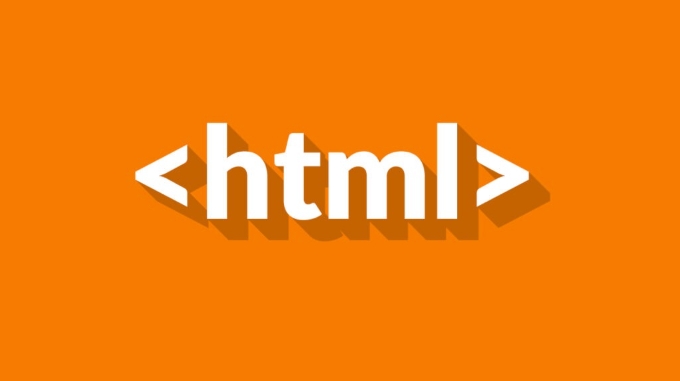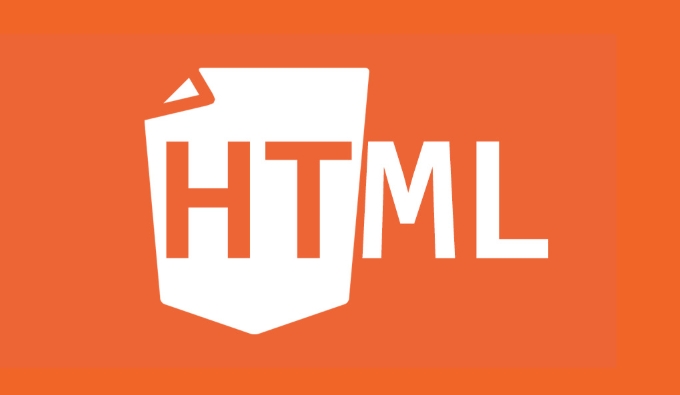Semantic HTML tags can improve the clarity and maintainability of web page structure. Its core advantages include: 1. Enhanced SEO, which is conducive to search engines to identify content; 2. Improve barrier-free experience, assistive technology can accurately parse pages; 3. The code is easier to collaborate and maintain. Common tags such as

Semantic HTML elements are tags that clearly express the meaning of their content. They do not exist for style, but for making the web page structure clearer and more logical, helping browsers, search engines and auxiliary tools better understand page content.

Why use semantic labels?
The biggest benefit of semantic tags is "to let the machine understand your web pages too." For example, <article></article> represents an article and <nav></nav> represents a navigation area. These tags are more descriptive than <div> or <code><span></span> . 
- For search engines, semantic structures help improve SEO rankings.
- For developers, the code is easier to maintain and collaborate.
- For assistive technologies (such as screen readers), semantic structures provide a better barrier-free experience.
If you are still using a bunch of <div class="header"> to write page structure, you can really consider changing to semantic tags such as <code><header></header> and <footer></footer> .
What are the common semantic HTML tags?
Here are some commonly used semantic elements that apply to most web structures:

-
<header></header>: Usually used on the top of a page or a certain block's title part -
<nav></nav>: specially used to wrap navigation links -
<main></main>: represents the main content of the page. There can only be one<main></main>on a page. -
<article></article>: Independent content blocks, such as blog posts or news entries -
<section></section>: chunks the content, each section usually has a title -
<aside></aside>: Sidebar, part related to main content but not core -
<footer></footer>: The bottom information of a page or block
Note: The key to using semantic tags is to have a clear structure, rather than just changing the name. For example, the following example: The benefits of writing this way are: But also avoid abuse. For example, don't nest too many layers in Semantic HTML is not a high-level trick, but it does make web page structure clearer and easier to maintain. While you may not see the direct effect it brings, its support for SEO and accessibility is very real. Basically all this is not complicated but easy to ignore.<section></section> is different from <section></section> is a structural semantic tag, while
How to use semantic tags correctly?
<article>
<header>
<h1>Article Title</h1>
<p>Author: Zhang San| Date: 2024-03-01</p>
</header>
<p>Body content...</p>
<footer>
<p>Tags: <a href="#">HTML</a>, <a href="#">Semanticization</a></p>
</footer>
</article>
<section></section> , and don't use semantic tags just to add styles.
A reminder at the end
The above is the detailed content of What are semantic HTML elements. For more information, please follow other related articles on the PHP Chinese website!

Hot AI Tools

Undress AI Tool
Undress images for free

Undresser.AI Undress
AI-powered app for creating realistic nude photos

AI Clothes Remover
Online AI tool for removing clothes from photos.

Clothoff.io
AI clothes remover

Video Face Swap
Swap faces in any video effortlessly with our completely free AI face swap tool!

Hot Article

Hot Tools

Notepad++7.3.1
Easy-to-use and free code editor

SublimeText3 Chinese version
Chinese version, very easy to use

Zend Studio 13.0.1
Powerful PHP integrated development environment

Dreamweaver CS6
Visual web development tools

SublimeText3 Mac version
God-level code editing software (SublimeText3)

Hot Topics
 Explain the purpose of the role attribute in ARIA.
Jun 14, 2025 am 12:35 AM
Explain the purpose of the role attribute in ARIA.
Jun 14, 2025 am 12:35 AM
ARIA's role attribute is used to define the role of web elements and improve accessibility. 1. Role attribute helps assistive technology to understand the functions of elements, such as buttons, navigation, etc. 2. Use role attributes to assign specific roles to non-semantic HTML elements. 3. The role attribute should be consistent with the element behavior and be verified by the accessibility tool test.
 HTML and Design: Creating the Visual Layout of Websites
Jun 14, 2025 am 12:39 AM
HTML and Design: Creating the Visual Layout of Websites
Jun 14, 2025 am 12:39 AM
How to create a website layout? 1. Use HTML tags to define the content structure, such as, ,. 2. Control styles and positions through CSS, using box model, float or Flexbox layout. 3. Optimize performance, reduce HTTP requests, use cache and optimize images, and ensure responsive design.
 How do I stay up-to-date with the latest HTML standards and best practices?
Jun 20, 2025 am 08:33 AM
How do I stay up-to-date with the latest HTML standards and best practices?
Jun 20, 2025 am 08:33 AM
The key to keep up with HTML standards and best practices is to do it intentionally rather than follow it blindly. First, follow the summary or update logs of official sources such as WHATWG and W3C, understand new tags (such as) and attributes, and use them as references to solve difficult problems; second, subscribe to trusted web development newsletters and blogs, spend 10-15 minutes a week to browse updates, focus on actual use cases rather than just collecting articles; second, use developer tools and linters such as HTMLHint to optimize the code structure through instant feedback; finally, interact with the developer community, share experiences and learn other people's practical skills, so as to continuously improve HTML skills.
 How do I use the element to represent the main content of a document?
Jun 19, 2025 pm 11:09 PM
How do I use the element to represent the main content of a document?
Jun 19, 2025 pm 11:09 PM
The reason for using tags is to improve the semantic structure and accessibility of web pages, make it easier for screen readers and search engines to understand page content, and allow users to quickly jump to core content. Here are the key points: 1. Each page should contain only one element; 2. It should not include content that is repeated across pages (such as sidebars or footers); 3. It can be used in conjunction with ARIA properties to enhance accessibility. Usually located after and before, it is used to wrap unique page content, such as articles, forms or product details, and should be avoided in, or in; to improve accessibility, aria-labeledby or aria-label can be used to clearly identify parts.
 How do I create a basic HTML document?
Jun 19, 2025 pm 11:01 PM
How do I create a basic HTML document?
Jun 19, 2025 pm 11:01 PM
To create a basic HTML document, you first need to understand its basic structure and write code in a standard format. 1. Use the declaration document type at the beginning; 2. Use the tag to wrap the entire content; 3. Include and two main parts in it, which are used to store metadata such as titles, style sheet links, etc., and include user-visible content such as titles, paragraphs, pictures and links; 4. Save the file in .html format and open the viewing effect in the browser; 5. Then you can gradually add more elements to enrich the page content. Follow these steps to quickly build a basic web page.
 What is an HTML tag?
Jun 13, 2025 am 12:36 AM
What is an HTML tag?
Jun 13, 2025 am 12:36 AM
HTMLtagsareessentialforstructuringwebpages.Theydefinecontentandlayoutusinganglebrackets,ofteninpairslikeand,withsomebeingself-closinglike.HTMLtagsarecrucialforcreatingstructured,accessible,andSEO-friendlywebpages.
 How do I create checkboxes in HTML using the element?
Jun 19, 2025 pm 11:41 PM
How do I create checkboxes in HTML using the element?
Jun 19, 2025 pm 11:41 PM
To create an HTML checkbox, use the type attribute to set the element of the checkbox. 1. The basic structure includes id, name and label tags to ensure that clicking text can switch options; 2. Multiple related check boxes should use the same name but different values, and wrap them with fieldset to improve accessibility; 3. Hide native controls when customizing styles and use CSS to design alternative elements while maintaining the complete functions; 4. Ensure availability, pair labels, support keyboard navigation, and avoid relying on only visual prompts. The above steps can help developers correctly implement checkbox components that have both functional and aesthetics.
 How do I minimize the size of HTML files?
Jun 24, 2025 am 12:53 AM
How do I minimize the size of HTML files?
Jun 24, 2025 am 12:53 AM
To reduce the size of HTML files, you need to clean up redundant code, compress content, and optimize structure. 1. Delete unused tags, comments and extra blanks to reduce volume; 2. Move inline CSS and JavaScript to external files and merge multiple scripts or style blocks; 3. Simplify label syntax without affecting parsing, such as omitting optional closed tags or using short attributes; 4. After cleaning, enable server-side compression technologies such as Gzip or Brotli to further reduce the transmission volume. These steps can significantly improve page loading performance without sacrificing functionality.






